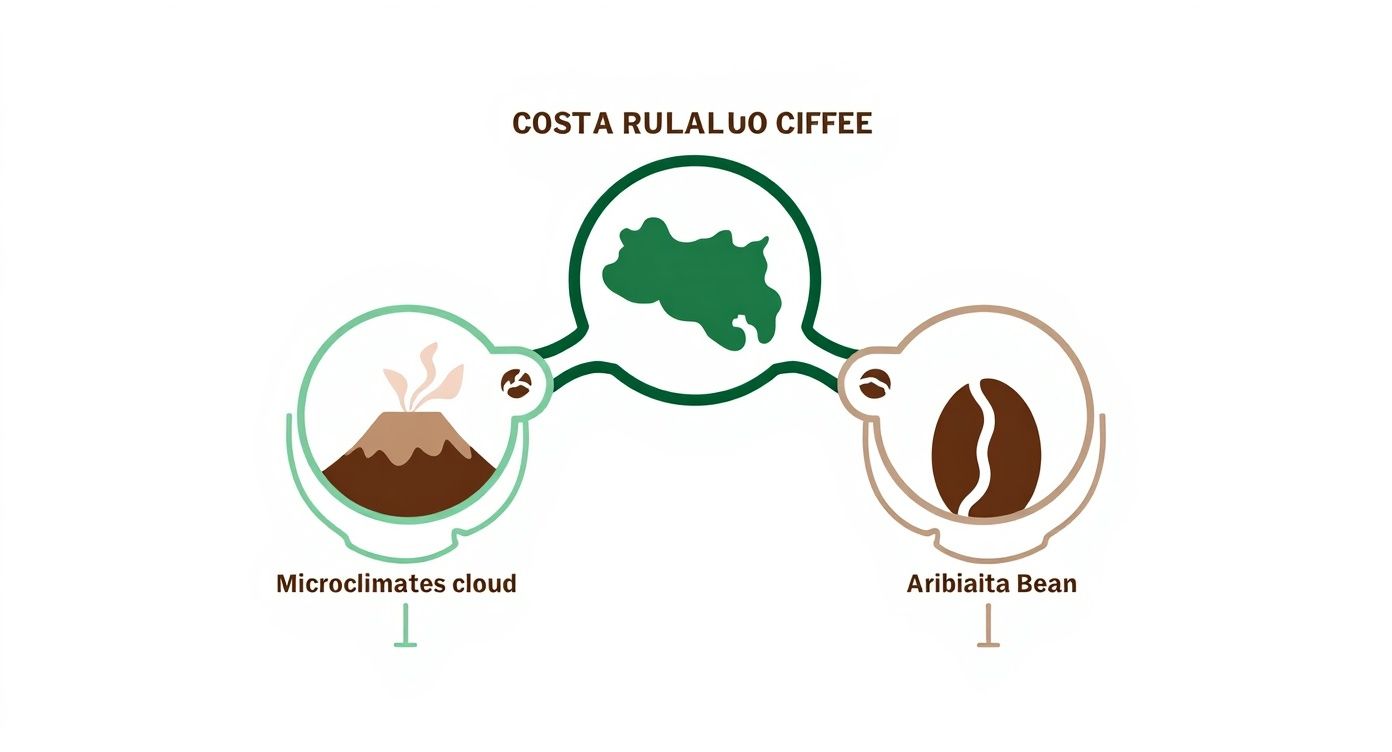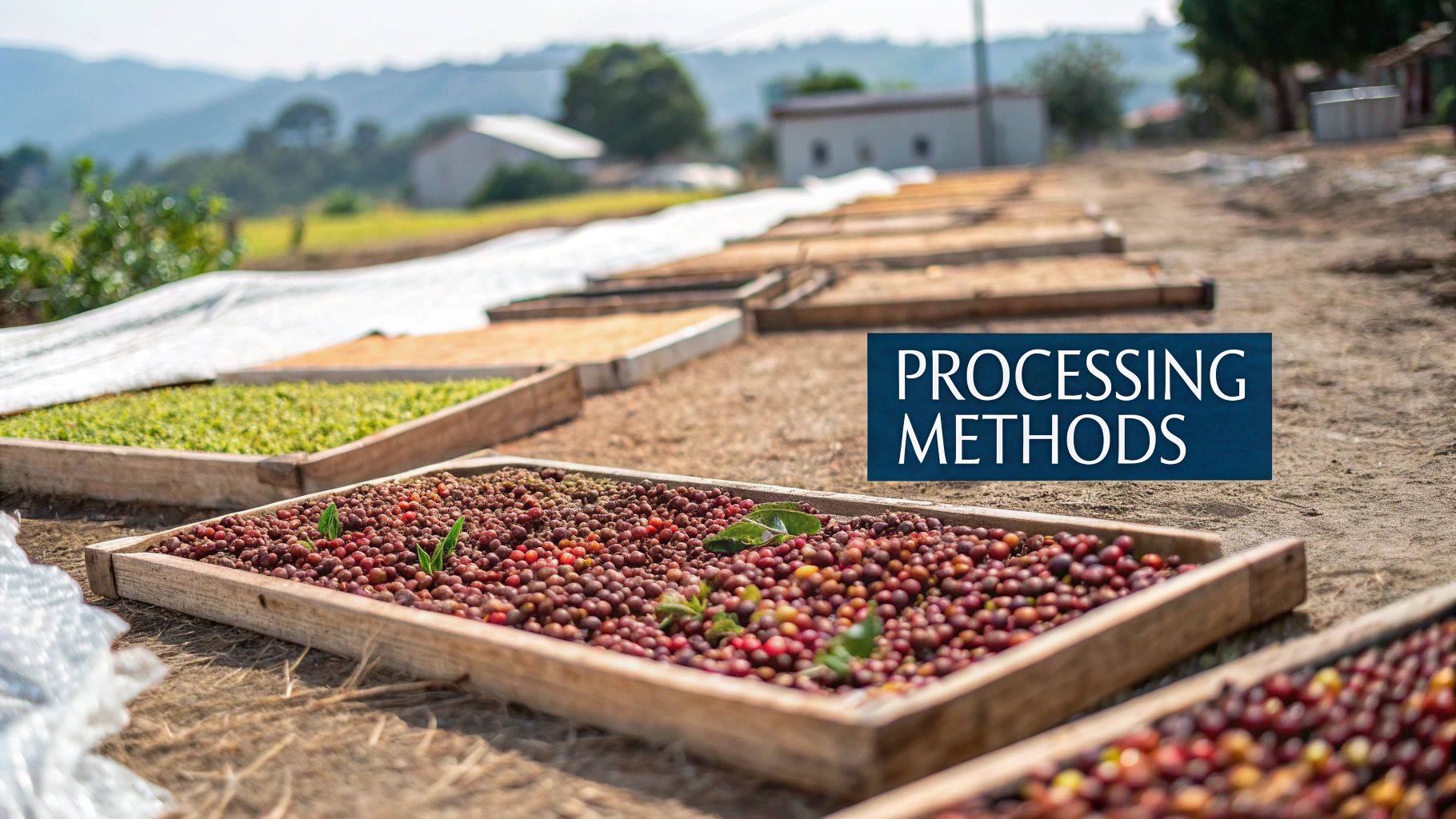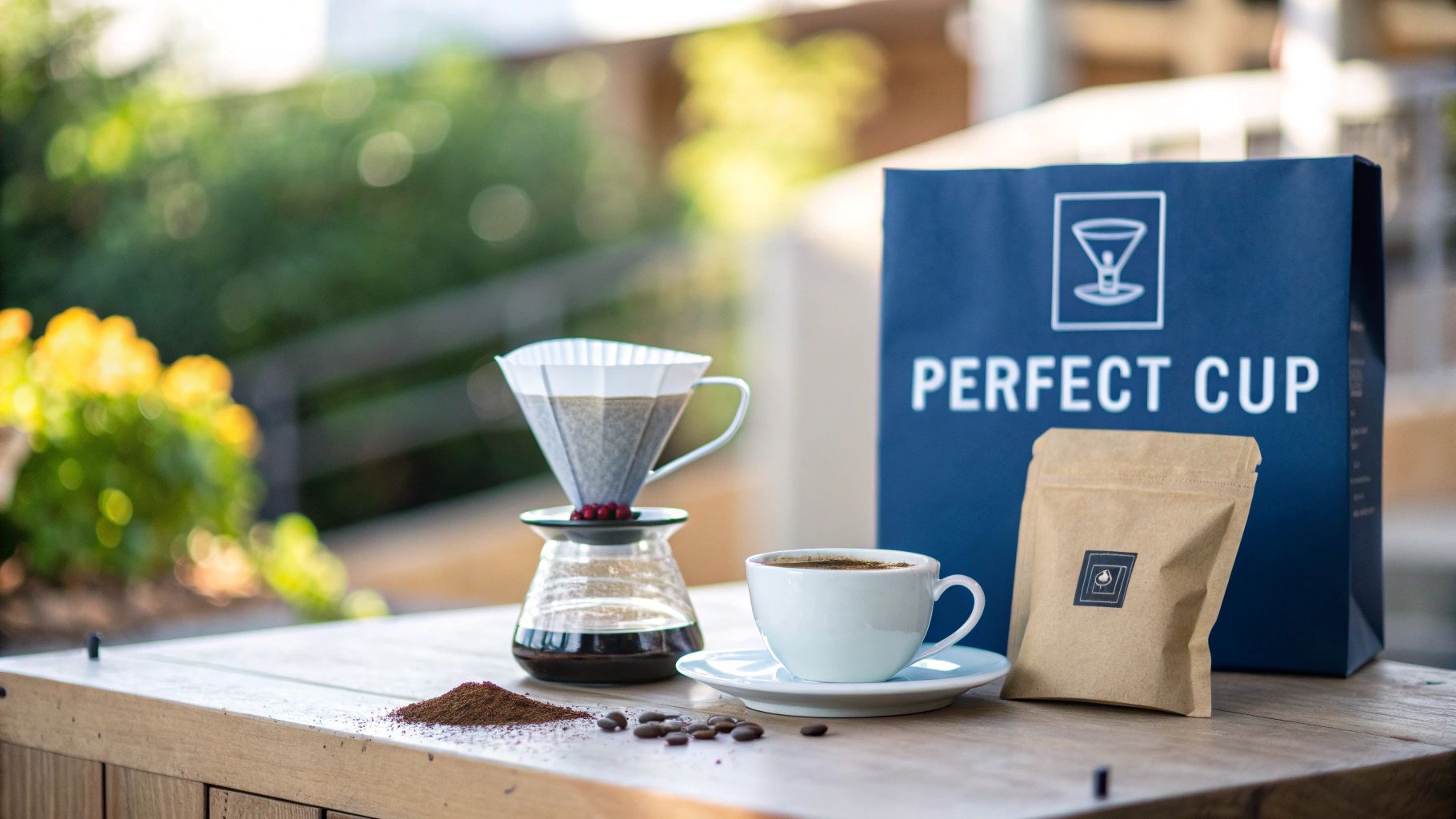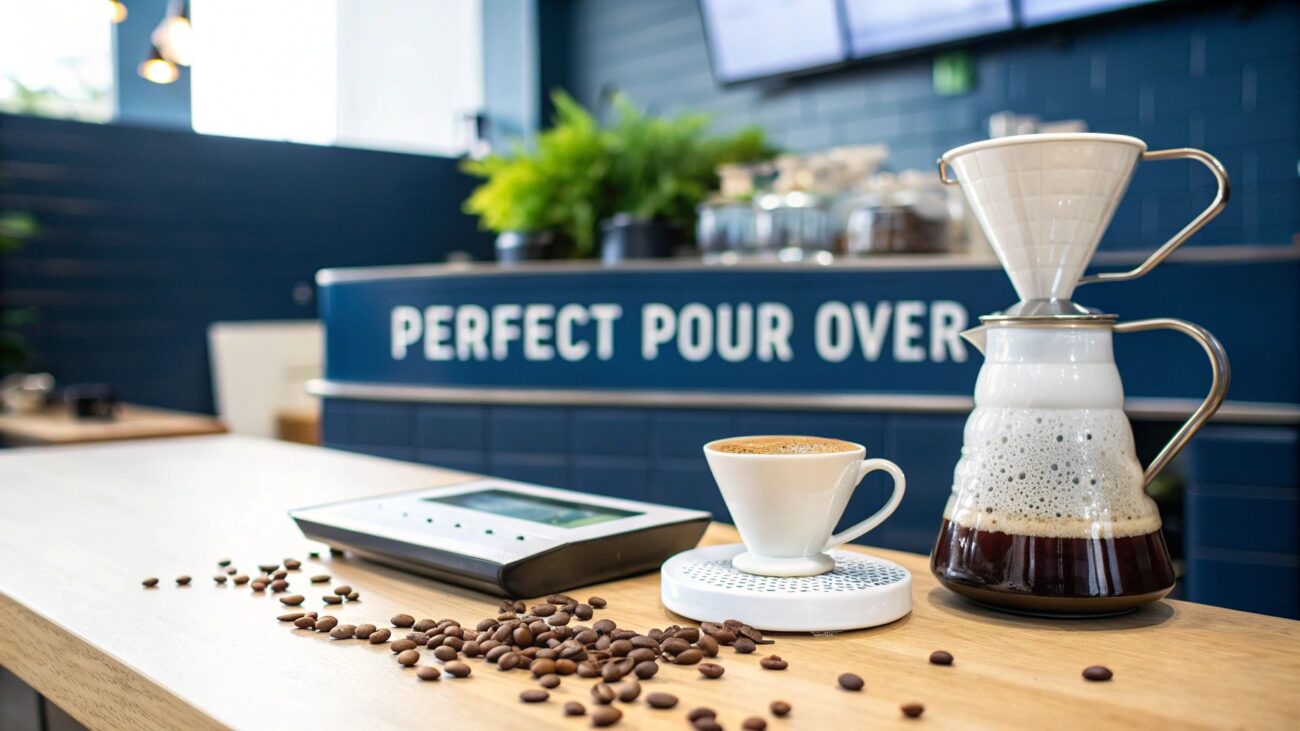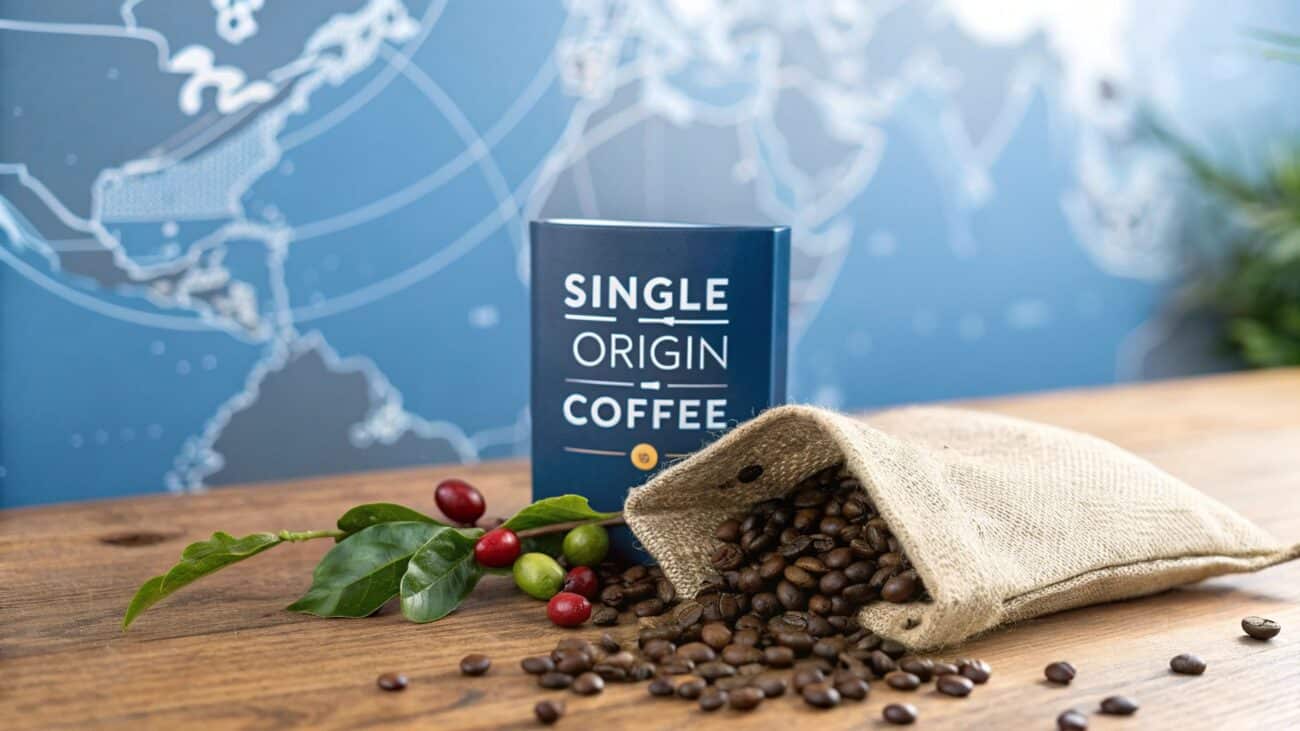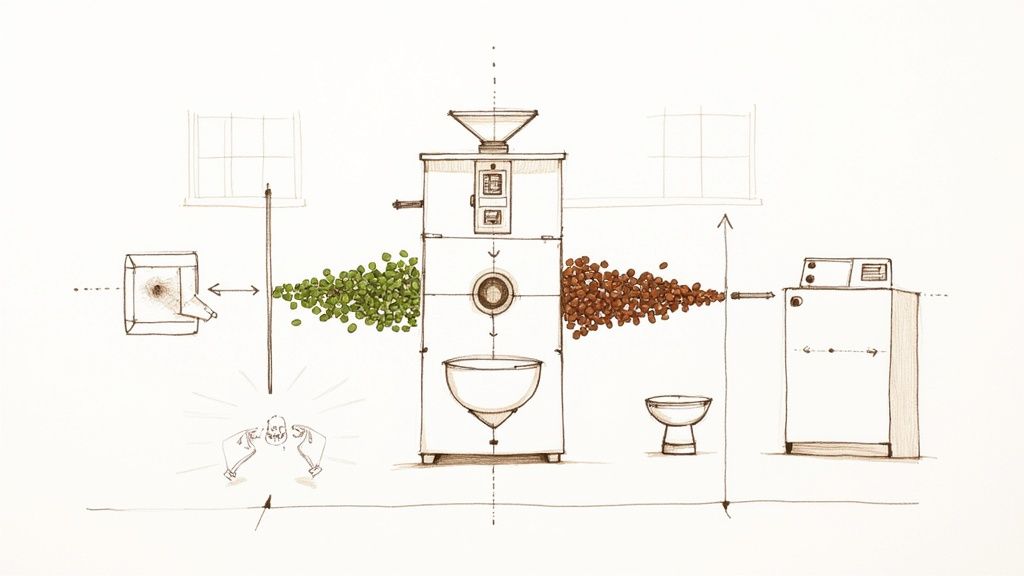A UK Guide to Costa Rican Coffee
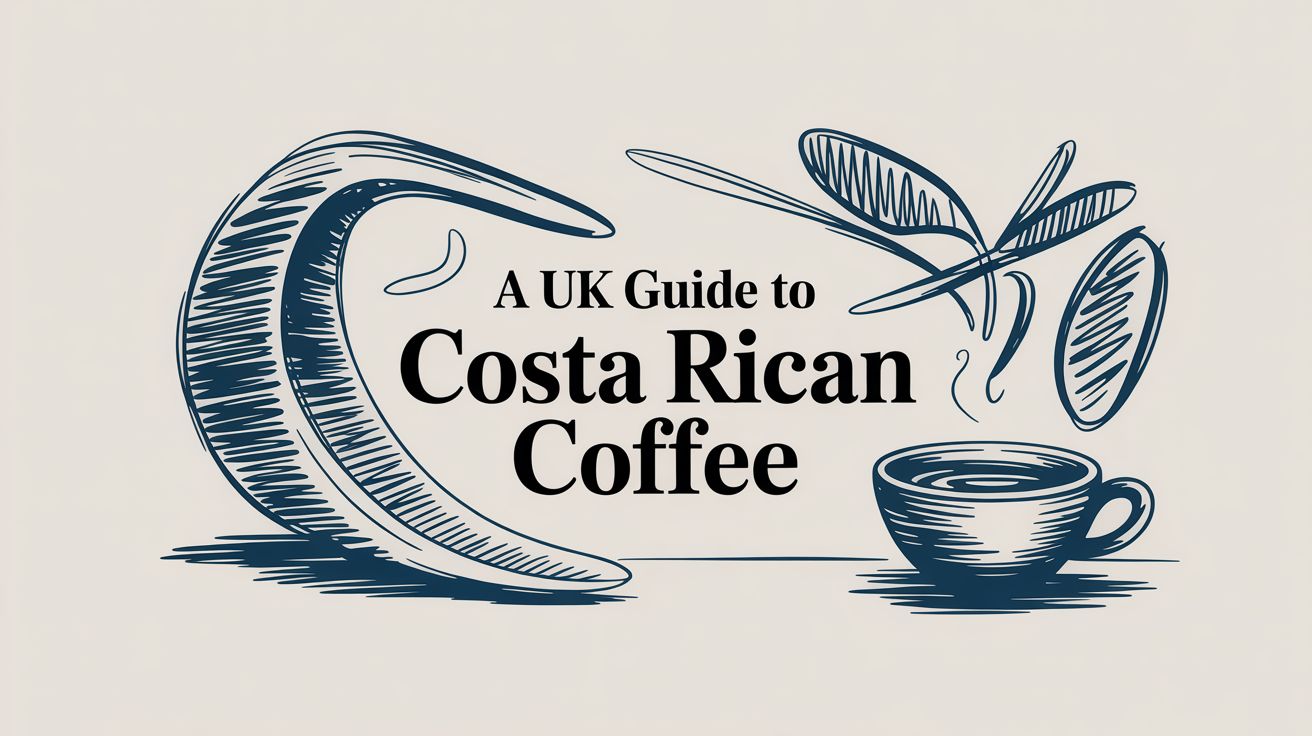
When you picture great coffee, your mind probably wanders to the highlands of Ethiopia or the sprawling plantations of Brazil. But tucked away in Central America, Costa Rica stands as a small but mighty force, producing some of the world's most sought-after beans. This isn’t a happy accident; it's the result of a deliberate, centuries-long dedication to quality over quantity.
Your Introduction to Costa Rica’s Golden Bean
The story of Costa Rican coffee is inseparable from its stunning geography. The country’s mountainous landscape is carpeted in rich volcanic soil, a natural powerhouse of minerals that nourish the coffee cherries as they grow. Think of it as a superfood for the coffee plants, giving them everything they need to develop deep, complex flavours.
The Perfect Environment for Coffee
But fertile ground is only part of the story. Costa Rica is blessed with a tapestry of microclimates where altitude, rainfall, and sunshine come together in perfect harmony for growing Arabica. This environmental trifecta is what the coffee world calls ‘terroir’—the unique stamp of character a coffee gets from the specific place it was grown.
These conditions are ideal for cultivating what are known as Strictly Hard Beans (SHB).
- Grown at High Altitudes: SHB coffees are grown at elevations soaring above 1,200 metres.
- Slower Maturation: The cooler air at these heights means the coffee cherries take their sweet time to ripen.
- Denser and More Flavourful: This slow-and-steady development creates harder, denser beans packed with more complex sugars and nuanced flavours.
This commitment to excellence is so ingrained that in 1989, the government passed a law making it illegal to grow lower-quality Robusta beans, cementing Arabica as the undisputed national standard.
Costa Rican coffee is often praised for its classic, clean taste. This is no coincidence. The meticulous processing and perfect growing conditions create a cup that is bright, beautifully balanced, and consistently delicious, making it a cornerstone of the speciality coffee movement. You can learn more about what is speciality coffee in our detailed guide.
This dedication to quality perfectly mirrors the national philosophy of ‘Pura Vida,’ or the ‘pure life’—an ethos that celebrates well-being, sustainability, and living in harmony with nature. This mindset flows directly into the coffee fields, where sustainable farming and ethical treatment of workers are held in high regard. For coffee lovers here in the UK, a cup of Costa Rican coffee offers more than just exceptional flavour; it’s a choice that supports environmental stewardship and a proud legacy of quality.
Exploring Costa Rica’s Premier Coffee Regions
When you think of Costa Rican coffee, it’s a mistake to imagine a single, uniform flavour. The reality is far more exciting. The country is a stunning mosaic of eight distinct coffee-growing regions, each with a personality shaped by its unique altitude, volcanic soil, and specific microclimate.
Think of it like the famous wine appellations of Bordeaux or Burgundy, where the terroir—the complete natural environment—defines the character of the grape. In the same way, these Costa Rican regions impart a signature taste to the coffee beans grown there. Getting to know these regional differences is the secret to finding a coffee that truly hits the spot for you.
From the soaring peaks of Tarrazú to the lush Central Valley, every area offers a different journey for your taste buds. This incredible variety is all down to the interplay between the environment and the coffee plant. The combination of nutrient-rich volcanic soil, specific weather patterns, and elevation creates a unique growing environment that shapes everything from the coffee cherry's acidity to its body and aroma.
The infographic below neatly captures the three pillars that form the foundation for the exceptional quality of Costa Rican coffee.
This really brings home how the country’s rich volcanic soil, diverse microclimates, and exclusive focus on the Arabica bean all come together to produce something special. These aren’t just agricultural footnotes; they are the essential ingredients that make Costa Rican coffee a treasure enjoyed the world over.
To help you navigate this flavour map, here's a quick look at the distinct tasting notes and characteristics you can expect from Costa Rica’s main growing areas.
Flavour Profiles of Costa Rican Coffee Regions
| Region | Altitude (Metres) | Dominant Flavour Profile | Acidity | Body |
|---|---|---|---|---|
| Tarrazú | 1,200–1,900 | Bright citrus, floral, clean finish | High, crisp | Medium |
| West Valley | 1,200–1,650 | Orange, peach, honey, creamy | Balanced | Medium |
| Tres Ríos | 1,200–1,650 | Plum, allspice, sweet aftertaste | Bright, light | Fine |
| Central Valley | 1,000–1,400 | Chocolate, fruit, honey aroma | Soft, gentle | Medium |
This table is just a starting point, of course. The real magic happens when you start exploring the coffees themselves and discover the subtle nuances each one has to offer.
The Crown Jewel of Costa Rican Coffee: Tarrazú
When coffee connoisseurs start talking about Costa Rica, the name Tarrazú almost always comes up first. Tucked away in the country's interior mountains, this region boasts some of the highest altitudes, with farms perched between 1,200 and 1,900 metres. This elevation is absolutely critical. The cooler mountain air causes the coffee cherries to ripen slowly, which results in beans that are incredibly dense, hard, and packed with complex flavours.
The result? A cup renowned for its crisp, bright acidity and a fine, elegant aroma often described as floral with hints of citrus. A well-brewed Tarrazú coffee delivers a clean, vibrant taste that simply dances on the tongue, making it a firm favourite for anyone who enjoys a lively and sophisticated brew. Its reputation is so highly regarded that "Tarrazú" is a legally protected designation, guaranteeing both authenticity and quality.
West Valley: A Symphony of Balanced Flavours
Just west of the capital, San José, you’ll find the West Valley, another of Costa Rica's coffee powerhouses. It’s celebrated for producing exceptionally well-balanced and complex coffees that consistently scoop up international awards. The region’s climate is a gift for coffee cultivation, with distinct wet and dry seasons that create the ideal conditions for both growing and processing.
Coffees from the West Valley are prized for their wonderfully balanced profile. You can typically expect a delicate sweetness with notes of orange, peach, and honey, all supported by a satisfyingly creamy body. It’s this harmonious blend of sweetness and gentle acidity that makes them so versatile and approachable, appealing to a huge range of coffee drinkers.
Tres Ríos: The Bordeaux of Costa Rica
Historically known as the "Bordeaux" of Costa Rica, the Tres Ríos region benefits from the incredibly rich soils of the Irazú Volcano. Although it's the smallest coffee-growing area in the country, its reputation is immense. The unique terroir here produces a bean with a truly refined and elegant character.
Coffees from Tres Ríos are famous for their incredible balance. They typically feature a light, bright acidity, a fine body, and a pleasingly sweet aftertaste with hints of plum and allspice. It's a classic, sophisticated profile that speaks to the region’s long and proud heritage in coffee production.
Central Valley: The Historic Heart of Coffee
The Central Valley is where Costa Rica's coffee story first began. Cradled by mountains and volcanoes like Poás and Barva, this region has a well-defined rainy season and fertile volcanic soil, creating the perfect storm for coffee cultivation. The beans grown here are known for their exceptional balance and subtle complexity.
- Flavour Profile: Expect a wonderfully well-rounded cup with a soft, gentle acidity.
- Aromatic Notes: You’ll often find hints of chocolate and fruit, complemented by a delicate honey aroma.
- Body: It offers a smooth medium body that makes for a consistently satisfying brew.
These regions represent just a taste of the diversity on offer. The best way to truly appreciate the unique character that each terroir imparts is by exploring different single-origin coffee beans. Once you understand these regional profiles, you can confidently choose a Costa Rican coffee that delivers the exact taste experience you’re searching for.
How Processing Methods Unlock Flavour
Once the ripe, red coffee cherries are picked by hand, they start a journey that’s absolutely critical. This next step, known as processing, is where the raw fruit is transformed into the stable green bean we can roast, and it's where a huge chunk of the coffee's final flavour is locked in. Costa Rican producers are masters of this craft, using different methods like a chef uses culinary techniques to bring out unique notes from the bean.
Think of it like cooking a potato. If you boil it, you get a clean, straightforward flavour. But if you roast it, you create something far more complex, with caramelised sweetness and a totally different texture. Processing does the same for a coffee bean, fundamentally shaping its acidity, body, and sweetness.
Costa Rica is famous for its expertise in three main processing methods. The secret to all of them is how much of the sticky, sugary fruit layer—the mucilage—is left on the bean while it dries. Getting this just right is how they unlock such an incredible spectrum of flavours.
Washed Process: The Clean Classic
The washed process is the most traditional method in Costa Rica and is the reason behind that classic, clean taste the country is famous for. Here, the coffee cherry's skin and all its fruity pulp are completely washed off with water before the beans are laid out to dry.
This is like giving the beans a thorough scrub, removing any external influences so the pure, intrinsic character of the bean itself can shine. The result is a coffee with a crisp, bright acidity and an exceptionally clean finish, highlighting the flavours it developed from its specific terroir and varietal.
Natural Process: The Fruity Original
The natural process, sometimes called the dry process, is the oldest coffee preparation method in the world. It’s beautifully simple: the entire coffee cherry is left completely intact and dried on raised beds under the sun. This allows all the sugars and fruit flavours from the cherry to slowly seep into the bean inside.
This technique creates a cup that is worlds apart from a washed coffee. It’s known for a heavy, syrupy body, much lower acidity, and intense, fruit-forward flavours. You can expect to find bold notes of strawberry, blueberry, and tropical fruits—a truly memorable experience.
The decision to use a specific processing method is a deliberate choice by the producer to craft a desired flavour profile. While washed processing reveals the bean's origin, natural and honey processes add layers of sweetness and complexity derived directly from the coffee fruit itself.
Honey Process: Costa Rica’s Signature Innovation
Where Costa Rican producers have really made their mark is in pioneering and perfecting the honey process. This clever method sits right between the washed and natural techniques, managing to capture the best of both worlds. The cherry's skin is removed, but a carefully controlled amount of the sticky mucilage is left clinging to the bean as it dries.
This "honey" mucilage gives the coffee a distinct sweetness and a wonderfully rounded body. The real genius, though, is how producers manage the amount of mucilage and the drying time to create a whole spectrum of honey styles, each with its own unique taste.
- Yellow Honey: With just a small amount of mucilage left on, these beans dry quite quickly in the sun. This creates a coffee with a balanced sweetness, a light body, and delicate notes of apricot and flowers.
- Red Honey: More mucilage is left on the bean for this one, and it dries more slowly, often in shaded conditions. This develops a deeper sweetness, a creamier body, and flavours that remind you of cherry and other red fruits.
- Black Honey: This is the most challenging and labour-intensive style, with almost all of the mucilage left on. The beans dry very, very slowly, creating a full-bodied, incredibly sweet coffee with complex notes of jam, chocolate, and brown sugar.
Understanding these processing methods is the key to truly appreciating the craft that goes into every cup of Costa Rican coffee. They aren’t just steps in a procedure; they are artistic choices that, along with the roast, define the final taste. If you're curious about how that next stage shapes your brew, you can find out more with our guide where coffee roasting profiles explained in detail.
The Ethical Heart of Costa Rican Coffee
Beyond its exceptional flavour, Costa Rican coffee has a powerful story rooted in a deep national commitment to sustainability and ethical practices. This isn't just a recent marketing trend; it’s a core part of the country's identity, woven into the fabric of its coffee industry for decades. The famous ‘Pura Vida’ philosophy extends right into the coffee fields, creating a culture that respects both the environment and the people who cultivate the beans.
This dedication has been formalised through some seriously forward-thinking national policies. Costa Rica has long been a global leader in environmental protection, and its coffee sector is a shining example of that leadership in action. The country has ambitious goals to become carbon-neutral, and its coffee farmers are crucial players in making that mission a reality.
Pioneering Sustainable Farming
One of the most significant initiatives is the Nationally Appropriate Mitigation Action (NAMA) for coffee. It's a groundbreaking programme designed to help coffee mills and farms adopt low-emission technologies and farming practices. The focus is on practical changes like reducing water usage during processing, managing waste responsibly, and improving soil health to cut down on greenhouse gas emissions.
Through NAMA, farmers get the tools and training they need to produce coffee more sustainably. This doesn’t just benefit the planet—it often leads to higher efficiency and better-quality beans, creating a win-win for producers and coffee lovers alike.
Decoding Ethical Certifications
When you're browsing for coffee, you’ll often see logos from organisations like Fair Trade or Rainforest Alliance on the packaging. These aren't just decorative stamps; they represent a serious commitment to social and environmental standards that make a real difference on the ground.
For a coffee to earn these certifications, it must meet stringent criteria. This ensures that the product you buy supports fair wages for farmers, safe working conditions, and practices that protect precious ecosystems and biodiversity.
Understanding what these labels mean can empower you to make choices that align with your values.
- Fair Trade: This certification zeroes in on the social and economic well-being of farmers. It guarantees a minimum price for their coffee, which protects them from volatile market fluctuations, and provides an additional premium for community development projects. You can learn more by reading our detailed guide on what Fair Trade coffee is and the impact it has.
- Rainforest Alliance: Recognisable by its green frog seal, this certification centres on environmental conservation. It promotes farming methods that protect forests, conserve water, and safeguard wildlife habitats, ensuring that the coffee is grown in harmony with nature.
A Growing UK Connection
This ethical approach resonates strongly with UK consumers, who are increasingly seeking transparency and social responsibility in the products they buy. This shift in preference is having a tangible impact on trade dynamics.
For example, a notable change occurred in the 2023/24 coffee year when exports from Costa Rica to the European Union (including the UK) surpassed those to the United States for the first time. The EU accounted for 41.5% of Costa Rican coffee exports, a trend clearly driven by a growing demand for coffee with clear traceability and strong environmental credentials. You can discover more insights about this shift in coffee export trends on mr-bean.coffee.
Choosing a bag of Costa Rican coffee is more than just a purchase; it's an investment in a system that values people and the planet.
How to Choose and Brew the Perfect Cup
Now that you have a feel for Costa Rica’s coffee landscape, it’s time for the best part: choosing and brewing your own incredible cup. Standing in front of a shelf of coffee bags can feel a bit overwhelming, but the label is your roadmap. Think of it as telling the story of the bean's origin, its journey, and all the flavour it holds inside.
Learning to read these details is the first step in turning your daily coffee from a routine into a ritual. With just a few key bits of information, you can confidently pick a coffee that hits all the right notes for your palate.
Reading the Coffee Bag Like an Expert
A coffee bag is more than just packaging; it's the bean's passport. It contains all the vital clues you need to predict what’s waiting for you inside. Here’s what to look for to make a smart choice.
- Region: As we've seen, where the coffee grew is a huge hint about its taste. A Tarrazú will likely be bright and citrusy, while a coffee from the West Valley might bring softer notes of peach and honey to the table.
- Processing Method: Keep an eye out for terms like 'washed,' 'natural,' or 'honey.' A washed coffee will give you a clean, crisp cup, while a natural process will pack an intense, fruity punch. Honey-processed beans strike a lovely balance with rounded sweetness.
- Roast Date: Freshness is everything in coffee. Always look for a clear roast date and grab a bag that was roasted within the last few weeks. That’s when the flavours are at their most vibrant.
- Tasting Notes: These are the roaster’s suggestions for the coffee’s main flavours—things like 'chocolate,' 'citrus,' or 'caramel.' They’re a brilliant guide to what you can expect.
By piecing these clues together, you can build a really clear picture. For example, a washed Tarrazú roasted last week with notes of lemon and jasmine promises a totally different experience from a black honey-processed West Valley coffee with hints of jam and brown sugar.
Tailoring Your Brew to the Bean
Once you’ve brought your Costa Rican coffee home, the next step is to brew it in a way that lets its unique character shine. Different brewing methods act like spotlights, highlighting different aspects of a coffee's profile, from its zesty acidity to its rich body.
The clean, bright acidity of a high-altitude Tarrazú, for instance, is absolutely beautiful when brewed with a pour-over like a V60. The paper filter and controlled pour let its delicate floral and citrus notes sing without anything weighing them down.
On the other hand, a coffee with a fuller body and chocolatey notes, like many from the Central Valley, is a perfect match for a French Press. This immersion method creates a rich, full-bodied cup that really amps up its natural sweetness and depth.
The goal of brewing is to extract the best possible flavour from the beans. Consider your brewing method a lens that can either sharpen the focus on bright, delicate notes or magnify the richness and body of the coffee.
For a fantastic all-rounder, an AeroPress works wonders with many Costa Rican coffees. Its pressure-based extraction creates a clean cup that really brings out the sweetness, making it ideal for the balanced profiles from regions like the West Valley. To get the best out of any method, a reliable process is key. For more detailed instructions, you can check out our guide on how to brew coffee for step-by-step advice.
The UK’s Growing Love for Costa Rican Coffee
The UK’s speciality coffee scene is absolutely buzzing, and Costa Rican coffee has carved out a special place in its heart. Coffee lovers and expert roasters alike are being won over by the incredible quality, transparency, and ethical sourcing behind these beans.
In fact, the UK market is a major fan. Speciality roasters across the country proudly feature Costa Rican coffees, showcasing profiles that range from chocolate and citrus to rich caramel. These roasters often build direct relationships with farmers, which really resonates with UK coffee drinkers who care more and more about where their coffee comes from and how it’s produced.
At Seven Sisters Coffee Co, our oxygen-free roasting technique is designed specifically to protect these delicate, origin-specific flavours. By shielding the beans from oxygen during the roast, we lock in the vibrant character that the region and processing method worked so hard to create. It means you get a fresher, more aromatic, and intensely flavourful brew, every single time.
Your Costa Rican Coffee Questions Answered
Diving into the world of speciality coffee always sparks a bit of curiosity. To help you feel more confident in your choices, we’ve put together some straightforward answers to the questions we hear most often about Costa Rican coffee.
This section is all about the essentials, giving you the practical know-how to appreciate what’s in your cup. Let’s get into what makes this coffee so special and break down some of the key terms you'll see on the bag.
Why Is Costa Rican Coffee So Highly Regarded?
Costa Rican coffee has earned its stellar reputation through a powerful combination of perfect growing conditions and a nationwide obsession with quality. The country is blessed with rich volcanic soils, soaring altitudes, and a whole host of microclimates, creating the ideal stage for growing complex, flavour-packed Arabica beans.
But it goes deeper than that. A historic government ban on growing lower-quality Robusta beans forced the entire industry to focus on one thing: producing the best Arabica possible. This shared commitment to excellence results in a consistently clean, bright, and beautifully balanced cup that has become a benchmark in the speciality coffee world.
What Does Strictly Hard Bean Mean?
You’ll often spot the term Strictly Hard Bean (SHB) on bags of Costa Rican coffee. This isn’t just fancy marketing speak; it’s a genuine mark of quality, reserved for coffees grown at altitudes above 1,200 metres.
At these cooler, higher elevations, the coffee cherries take their sweet time to mature. This long, slow ripening period allows more complex sugars and acids to develop inside. The result is a bean that's physically denser and packed with more nuanced, vibrant flavours.
In short, when you see SHB, you know you’re getting a high-quality, flavourful coffee. It’s a reliable shortcut to a better brew.
Does It Have More Caffeine?
Generally speaking, the caffeine in Costa Rican coffee is right on par with other Arabica beans from around the globe. Caffeine levels have more to do with the coffee species (Arabica vs. Robusta) than the country it comes from.
Since Costa Rica grows Arabica exclusively—which is naturally lower in caffeine than Robusta—you can expect a smooth, flavourful experience without an over-the-top jolt. This reputation for premium, traceable, and delicious beans is a big reason for the strong trade relationship with the UK, where exports across various sectors, including coffee, hit around $259.63 million in 2024. You can read more about UK-Costa Rica trade relations on publishing.service.gov.uk.
Ready to taste the Pura Vida spirit for yourself? Explore the exceptional range of single-origin beans at Seven Sisters Coffee Co and experience the vibrant, clean flavours of Costa Rican coffee, perfectly preserved with our oxygen-free roasting process. Discover your new favourite today at https://sevensisterscoffee.co.uk.

